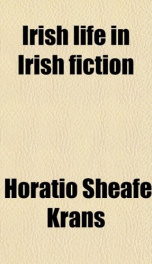irish life in irish fiction

Purchase of this book includes free trial access to www.million-books.com where you can read more than a million books for free. This is an OCR edition with typos. Excerpt from book: CHAPTER III THE NOVELISTS OP THE PEASANTRY At the close of the first quarter of the nineteenth century a group of young writers began to appear whose works were more national and more worthy of being considered as an elucidation of Irish life and the character of the race than those of any previous novelist, except perhaps Miss Edgeworth. This is the group of novelists of the peasantry. They were all of Celtic stock, and bred in the Catholic faith. At this time O'ConnelFs agitation had awakened the Irish Catholics, and there is doubtless a connection between this little outburst of literary energy and the repeal of Catholic disabilities. There is a strong contrast between the careers of these novelists of the peasantry and the gentry novelists. Lady Morgan in her theatrical and literary Bohemia or in Belgravia, Maxwell and his sporting life, Lever's high-living and gay company, the comfortable lives of Miss Edge- worth, the Crokers and Mrs. Hall, and Lover drolling it in the drawing-rooms of Dublin or London,, make a series of pictures quite different from that of John Banim's harassed, hand-to- mouth existence, Griffin's fight for bread and fame, and the necessitous career of Carleton, struggling for education and a livelihood. With the novelists of the peasantry the devil-may-care temper that gave the novels of the gentry their characteristic tone no longer rules. They cannot take hold of life in the same free, off-hand manner. John Banim, the first of the group, was born in 1798, the year of the Rebellion, and the same in which Croker and Carleton first saw the light, in Kilkenny, where his father a bit of old Ireland in his testy temper, his warm heart, and his love of a social glass was engaged in the double occupation of farmer and shopkeeper, in the latter c...
Info about the book
Author:
Series:
Unknown
ISBN:
1178645819
Rating:
2.5/5 (4)Your rating:
0/5
Languge:
English
Users who have this book
Users who want this book
What readers are saying
What do you think? Write your own comment on this book!
write a commentGenre
if you like irish life in irish fiction try:
Other books by this author
Do you want to read a book that interests you? It’s EASY!
Create an account and send a request for reading to other users on the Webpage of the book!


